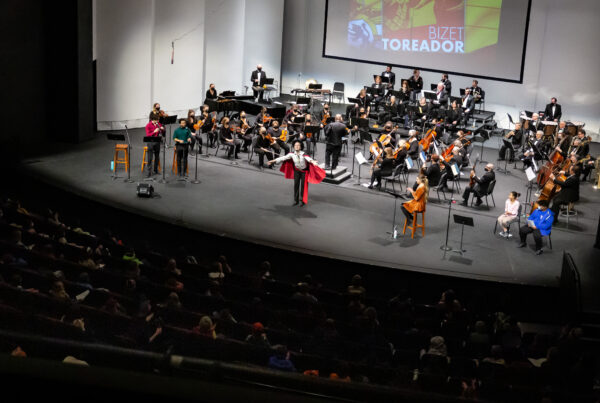Flagstaff has an uncommon opportunity to hear the distinctive resonant tones of the alto saxophone in the context of an orchestra, when local soloist Jonathan Bergeron performs the GlazunovAlto Saxophone Concertowith the Flagstaff Symphony Orchestra on Friday, Feb. 15.
Music Director Charles Latshaw conducts the performance in Ardrey Memorial Auditorium on the Northern Arizona University campus, beginning at 7:30 pm. The audience is invited to attend a pre-concert conversation with the conductor and soloist at 6:30.
The alto saxophone was not invented until the 1840s, so it doesn’t figure in the great symphonic works of the Classical and Romantic periods; it has been used primarily as a jazz or band instrument. The instrument was still relatively new when Alexander Glazunov wrote this concerto in 1934 and he was intrigued by the novel tone quality of the sax.
Jonathan Bergeron, the soloist, is Associate Professor of Saxophone at Northern Arizona University where he directs the NAU Saxophone Orchestra. In addition to teaching, Dr. Bergeron has performed throughout the U.S. and Europe as a soloist and chamber musician. One reviewer has said, “His tone and vibrato provided the audience with a palette painted with many colors.”
The concert opens with the great composer Johann Sebastian Bach, who wrote his Fantasia & Fugue in C minor around 1723, while his fame as an organist developed in Weimar, Germany. Two hundred years later, British composer Sir Edward Elgar transcribed this organ work for full orchestra in 1922. Elgar claimed he wanted “to show how gorgeous and great and brilliant [Bach] would have made himself sound if he had had our means.”
After intermission, the orchestra performs Petite Suite(1889), by Claude Debussy, the French composer. He originally wrote it as a piano piece for four hands, having been asked to create a piece that could be played by “skilled amateurs.”
The concert concludes with Symphonic Metamorphosis of Themes by Carl Maria von Weber, by German composer Paul Hindemith. Weber (1786-1826) was one of the first German Romantic composers. Hindemith adapted melodies from several of Weber’s works for a ballet, basing each movement on one theme. First performed in 1944 by the New York Philharmonic-Symphony Orchestra, this has since become Hindemith’s most popular work. George Balanchine choreographed it as the popular “Metamorphoses” for the New York City Ballet.



